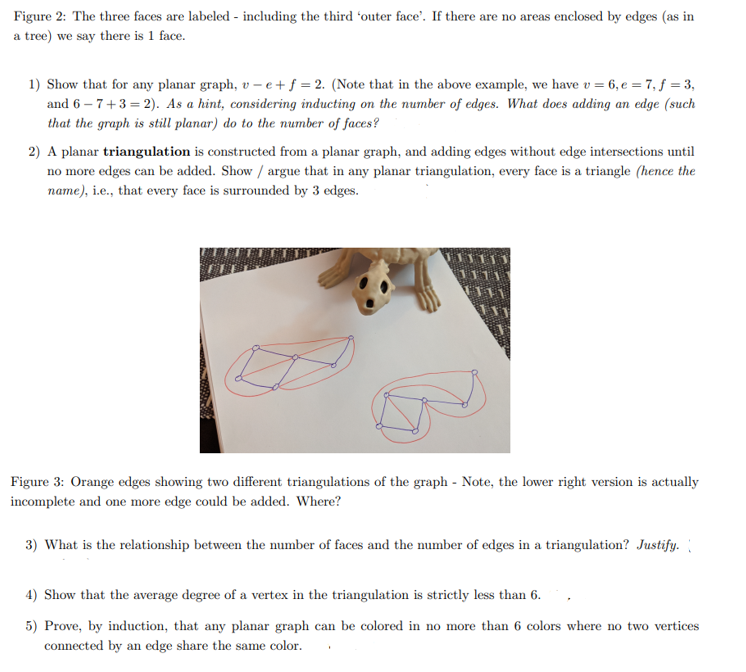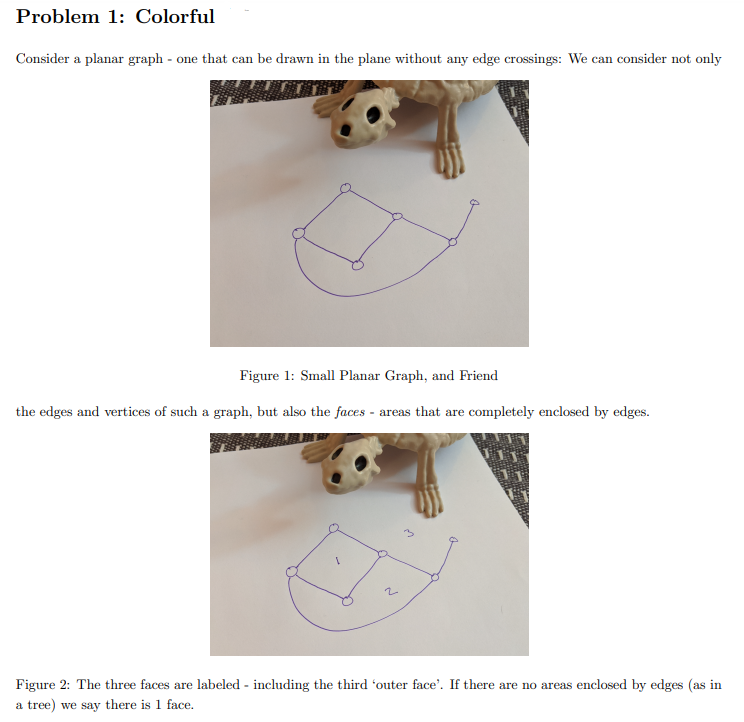Figure 2: The three faces are labeled - including the third 'outer face'. If there are no areas enclosed by edges (as in a tree) we say there is 1 face. 1) Show that for any planar graph, v – e + f = 2. (Note that in the above example, we have v = 6, e = 7, f = 3, and 6 – 7+3 = 2). As a hint, considering inducting on the number of edges. What does adding an edge (such that the graph is still planar) do to the number of faces? 2) A planar triangulation is constructed from a planar graph, and adding edges without edge intersections until no more edges can be added. Show / argue that in any planar triangulation, every face is a triangle (hence the name), i.e., that every face is surrounded by 3 edges.
Figure 2: The three faces are labeled - including the third 'outer face'. If there are no areas enclosed by edges (as in a tree) we say there is 1 face. 1) Show that for any planar graph, v – e + f = 2. (Note that in the above example, we have v = 6, e = 7, f = 3, and 6 – 7+3 = 2). As a hint, considering inducting on the number of edges. What does adding an edge (such that the graph is still planar) do to the number of faces? 2) A planar triangulation is constructed from a planar graph, and adding edges without edge intersections until no more edges can be added. Show / argue that in any planar triangulation, every face is a triangle (hence the name), i.e., that every face is surrounded by 3 edges.
Calculus: Early Transcendentals
8th Edition
ISBN:9781285741550
Author:James Stewart
Publisher:James Stewart
Chapter1: Functions And Models
Section: Chapter Questions
Problem 1RCC: (a) What is a function? What are its domain and range? (b) What is the graph of a function? (c) How...
Related questions
Question
please send handwritten solution for Q5 for getting upvote

Transcribed Image Text:Figure 2: The three faces are labeled - including the third 'outer face'. If there are no areas enclosed by edges (as in
a tree) we say there is 1 face.
1) Show that for any planar graph, v – e + f = 2. (Note that in the above example, we have v = 6, e = 7, f = 3,
and 6 – 7+3 = 2). As a hint, considering inducting on the number of edges. What does adding an edge (such
that the graph is still planar) do to the number of faces?
2) A planar triangulation is constructed from a planar graph, and adding edges without edge intersections until
no more edges can be added. Show / argue that in any planar triangulation, every face is a triangle (hence the
name), i.e., that every face is surrounded by 3 edges.
Figure 3: Orange edges showing two different triangulations of the graph - Note, the lower right version is actually
incomplete and one more edge could be added. Where?
3) What is the relationship between the number of faces and the number of edges in a triangulation? Justify.
4) Show that the average degree of a vertex in the triangulation is strictly less than 6.
5) Prove, by induction, that any planar graph can be colored in no more than 6 colors where no two vertices
connected by an edge share the same color.

Transcribed Image Text:Problem 1: Colorful
Consider a planar graph - one that can be drawn in the plane without any edge crossings: We can consider not only
Figure 1: Small Planar Graph, and Friend
the edges and vertices of such a graph, but also the faces - areas that are completely enclosed by edges.
Figure 2: The three faces are labeled - including the third 'outer face'. If there are no areas enclosed by edges (as in
a tree) we say there is 1 face.
Expert Solution
This question has been solved!
Explore an expertly crafted, step-by-step solution for a thorough understanding of key concepts.
This is a popular solution!
Trending now
This is a popular solution!
Step by step
Solved in 2 steps with 3 images

Recommended textbooks for you

Calculus: Early Transcendentals
Calculus
ISBN:
9781285741550
Author:
James Stewart
Publisher:
Cengage Learning

Thomas' Calculus (14th Edition)
Calculus
ISBN:
9780134438986
Author:
Joel R. Hass, Christopher E. Heil, Maurice D. Weir
Publisher:
PEARSON

Calculus: Early Transcendentals (3rd Edition)
Calculus
ISBN:
9780134763644
Author:
William L. Briggs, Lyle Cochran, Bernard Gillett, Eric Schulz
Publisher:
PEARSON

Calculus: Early Transcendentals
Calculus
ISBN:
9781285741550
Author:
James Stewart
Publisher:
Cengage Learning

Thomas' Calculus (14th Edition)
Calculus
ISBN:
9780134438986
Author:
Joel R. Hass, Christopher E. Heil, Maurice D. Weir
Publisher:
PEARSON

Calculus: Early Transcendentals (3rd Edition)
Calculus
ISBN:
9780134763644
Author:
William L. Briggs, Lyle Cochran, Bernard Gillett, Eric Schulz
Publisher:
PEARSON

Calculus: Early Transcendentals
Calculus
ISBN:
9781319050740
Author:
Jon Rogawski, Colin Adams, Robert Franzosa
Publisher:
W. H. Freeman


Calculus: Early Transcendental Functions
Calculus
ISBN:
9781337552516
Author:
Ron Larson, Bruce H. Edwards
Publisher:
Cengage Learning